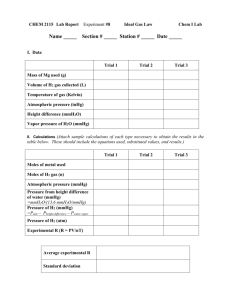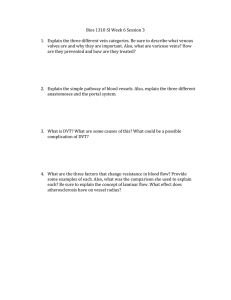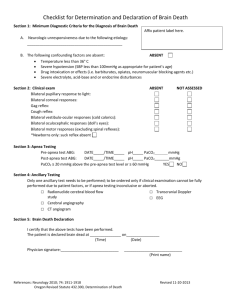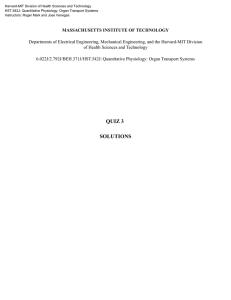Harvard-MIT Division of Health Sciences and Technology
advertisement
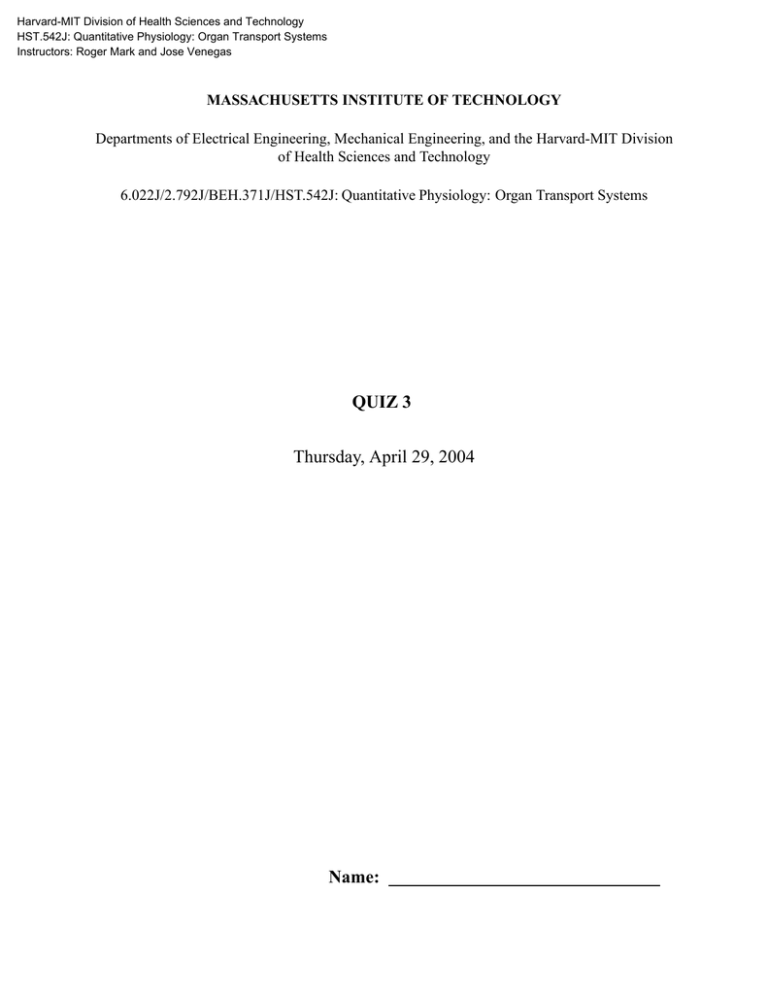
Harvard-MIT Division of Health Sciences and Technology HST.542J: Quantitative Physiology: Organ Transport Systems Instructors: Roger Mark and Jose Venegas MASSACHUSETTS INSTITUTE OF TECHNOLOGY Departments of Electrical Engineering, Mechanical Engineering, and the Harvard-MIT Division of Health Sciences and Technology 6.022J/2.792J/BEH.371J/HST.542J: Quantitative Physiology: Organ Transport Systems QUIZ 3 Thursday, April 29, 2004 Name: These are normal values of physiological parameters for a 70 kg person. Rrs (respiratory system R) Ccw Clung VD (Anatomic) VO� 2 � VCO 2 RQ Q s /Q T (Shunt fraction) Q T (cardiac output) Patm PvCO2 PvO2 PaCO2 PaO2 (at room air) ( A − a)D O2 pH cHb Hb O2 Binding capacity FRC = = = = = = = < = = = = = = ≈ = = = = 4 200 200 150 274 220 0.8 0.05 5 760 46 40 40 100 6-10 7.4 15 20.1 2.4 mbar·s/l ml/mbar ml/mbar ml ml/min ml/min l/min mmHg mmHg mmHg mmHg mmHg mmHg g/100ml-blood ml O2/100ml blood l The normal hemoglobin O2 saturation curve is also included and should be used only when there is no alternative data available. Figure 1: The first two problems are cases that include certain respiratory physiologic abnormalities. You can use the normal values as a reference, or in absence of additional information. 6.022j—2004: Quiz 3 2 Problem 1 (Case 1) A patient comes to the emergency ward with shortness of breath and wheezing. He is breath­ ing room air at a rate of 30 breaths per minute, and the pulse oximeter shows his arterial blood saturation to be SaO2 = 0.80. Arterial and mixed venous blood samples are taken at arrival and reveal the following values: PvCO2 PvO2 PaCO2 PaO2 (at room air) = = = = 44 27 39 20 mmHg mmHg mmHg mmHg The blood gas data comes with a computer generated caution questioning the validity of the measurements. A. Please identify which of the four blood gas values may have an error and explain your rea­ soning. (25%) B. You need to make a best guess to treat the patient with the knowledge available to you; can you find an approximate value of the erroneous blood gas? (25%) C. The patient is given 100% O2 by mask and one hour later his blood gases come back: PvCO2 PvO2 PaCO2 PaO2 = = = = 48 47 42 60 mmHg mmHg mmHg mmHg This time without caution notes. What can you say about the cause of gas exchange impairment in this patient? (50%) Hint, you can ignore the oxygen carrying capacity of plasma in your calculations. 6.022j—2004: Quiz 3 3 Problem 2 (Case 2) The same patient eventually develops respiratory failure and is placed on a mechanical ventilator adjusted to parameters matching his tidal breathing: VT = 390 ml f = 30 bpm Tins = 40% Texp = 50% Fi O2 = 0.50 And his blood gases are measured as: PvCO2 PvO2 PaCO2 PaO2 = = = = 42 45 40 275 mmHg mmHg mmHg mmHg V̇O2 V̇CO2 = = 274 ml/min 220 ml/min The ventilator output shows the following screen Figure 2: 6.022j—2004: Quiz 3 4 A. Is this patient exhibiting dynamic hyper-inflation, and why or why not? (25%) B. Can you estimate the patient’s respiratory system mechanical parameters: Resistance and Compliance? (25%) C. The attending MD suggests decreasing frequency while keeping the inspiration (insufflation in Germanic English) and exhalation time % unchanged. What frequency and tidal volume would you choose? Assume that the VD physiologic remains unchanged. (50%) (Note: if you decide to use VD anatomic in your calculation, you will lose 25% of the question points.) 6.022j—2004: Quiz 3 5 Problem 3 Pulmonary fibrosis is a debilitating disease of the lung characterized by replacement of elastin by collagen and resulting in a decrease of lung compliance. In severe cases, lung transplant is the only option for survival. To maximize organ availability and reduce post-operative mortality, usually unilateral lung transplant is conducted. A. First draw the normal chest wall and lung compliance curves. Then draw changes that result from pulmonary fibrosis (C L reduced by 1/2). Assume that compliances are linear and that the chest wall compliance does not change. What happens with FRC in pulmonary fibrosis? (25%) B. Second, draw the effects of replacing one of the lungs with a normal donor lung. What will be the new FRC after surgery? You can assume that both right and left lungs have equal compliance before surgery. (25%) 6.022j—2004: Quiz 3 6 C. How does the amount of pressure required to inspire a similar tidal volume compare between before and after surgery? (25%) D. In what proportions is the tidal volume distributed between both lungs? (25%) 6.022j—2004: Quiz 3 7


